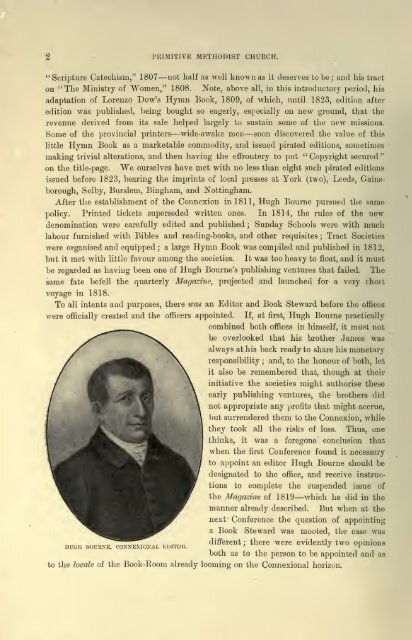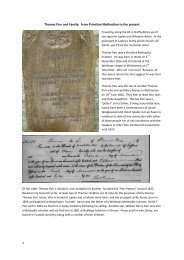Vol 2, pages 1-100 - My Primitive Methodist Ancestors
Vol 2, pages 1-100 - My Primitive Methodist Ancestors
Vol 2, pages 1-100 - My Primitive Methodist Ancestors
You also want an ePaper? Increase the reach of your titles
YUMPU automatically turns print PDFs into web optimized ePapers that Google loves.
PRIMITIVE METHODIST CHURCH.<br />
" Scripture Catechism," 1807 not half as well known as it deserves to be ;<br />
and his tract<br />
on "The Ministry of Women," 1808. Note, above all, in this introductory period, his<br />
adaptation of Lorenzo Dow's Hymn Book, 1809, of which, until 1823,<br />
edition after<br />
edition was published, being bought so eagerly, especially on new ground, that the<br />
revenue derived from its sale helped largely<br />
to sustain some of the new missions.<br />
Some of the provincial printers wide-awake men soon discovered the value of this<br />
little Hymn Book as a marketable commodity, and issued pirated editions, sometimes<br />
making trivial alterations, and then having the effrontery to put " Copyright secured "<br />
on the title-page. We ourselves have met with no less than eight such pirated editions<br />
issued before 1823, bearing the imprints of local presses at York (two), Leeds, Gainsborough,<br />
Selby, Burslem, Bingham, and Nottingham.<br />
After the establishment of the Connexion in 1811, Hugh Bourne pursued the same<br />
policy. Printed tickets superseded written ones. In 1814, the rules of the new<br />
denomination were carefully edited and published ; Sunday Schools were with much<br />
labour furnished with Bibles and reading-books, and other requisites ;<br />
Tract Societies<br />
were organised and equipped a<br />
; large Hymn Book was compiled and published in 1812,<br />
but it met with little favour among the societies. It was too heavy to float, and it must<br />
be regarded as having been one of Hugh Bourne's publishing ventures that failed. The<br />
same fate befell the quarterly Magazine, projected and launched for a very short<br />
voyage in 1818.<br />
To all intents and purposes, there was an Editor and Book Steward before the offices<br />
were officially created and the officers appointed. If, at first, Hugh Bourne practically<br />
combined both offices in himself, it must not<br />
HUGH BOUUNE, CONNEXIONAL K1JITOU.<br />
be overlooked that his brother James was<br />
always at his back ready to share his monetary<br />
responsibility ;<br />
and, to the honour of both, let<br />
it also be remembered that, though at their<br />
initiative the societies might authorise these<br />
early publishing ventures, the brothers did<br />
not appropriate any profits that might accrue,<br />
but surrendered them to the Connexion, while<br />
they took all the risks of loss. Thus, one<br />
thinks, it was a foregone conclusion that<br />
when the first Conference found it necessary<br />
to appoint an editor Hugh Bourne should be<br />
designated to the office, and receive instructions<br />
to complete the suspended issue of<br />
the Magazine of 1819 which he did in the<br />
manner already described. But when at the<br />
next' Conference the question of appointing<br />
a Book Steward was mooted, the case was<br />
different ;<br />
there were evidently two opinions<br />
both as to the person to be appointed and as<br />
to the locale of the Book-Room already looming on the Connexional horizon.



